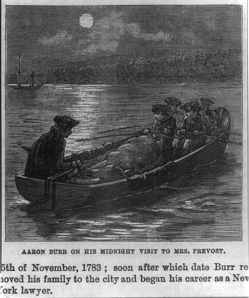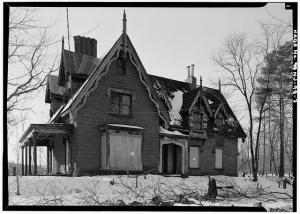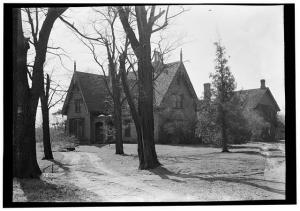Although this building and its history do not fit with my research topic, the Hermitage is still an important and central part of Ho-Ho-Kus. One of the oldest structures in the borough, the Hermitage was built in 1763 as a two-story brownstone house.[1] As advertised in 1763 by Elizabeth Lane, the lot was about 105
acres and ready to be used as a plantation, “there is on the same a good new Stone Dwelling House 40 foot front, and 23 foot back, the front is all of hewn stone, a Cellar under the Whole, and a Well of good Water before the Door.”[2] The Hermitage is much bigger now but there are still pieces of the 1763 house remaining. For example, the stone walls and the cellar still remain. In addition, Ho-Ho-Kus still drinks well water and it’s still ‘good.’ Parts of the structure from the 1763 renovations have been preserved as portions of the present-day house.
Just like today, people during the pre-Revolutionary War period moved from cities into more rural or suburban areas. In 1767, Ann Bartow De Visme moved her family out of Manhattan and into the rural area of Ho-Ho-Kus. Ann had five children; one of them, Theodosia, was married to James Marcus Prevost.[3] Theodosia inherited the house and became the primary owner some time before 1776.
During the Revolutionary War, Lt. Col. James Marcus Prevost was a loyalist, fighting for the British. With battles being fought throughout the colonies, Theodosia was worried that her precious home would be overtaken and destroyed by the patriots. By July 1778, the word had spread that General Washington and his troops were going to be passing through Ho-Ho-Kus. In a preemptive strike to protect her home, she decided to invite General George Washington and his troops to stay on the property as guests. The U.S. troops were entertained at the Hermitage for four days, July 10-14, 1778. During this visit, Theodosia met Aaron Burr who she would marry only a few years later.[4]

This is a wooden engraving of Aaron Burr taking a boat ride to see Mrs. Theodosia Prevost, as stated in the caption above.
On July 2, 1782, Theodosia married Aaron Burr at the Hermitage. Many of the attending guests she had met during the numerous times she offered her house and land to soldiers. Guests of the wedding included Lord Sterling, or General William Alexander, James Monroe, the French commander and close friend of General Washington, the Marquis du Lafayette, Peggy Shippen Arnold, and Alexander Hamilton.[5]
In 1807, the house was sold to Elijah Rosegrant (later changed to Rosencrantz), a local doctor. Elijah was married to Cornelia Suffern, whose family lived in Rockland County, New York and operated a grist and saw mill.[6] Elijah made very little money working as a doctor in the area. After realizing how well his father-in-law was doing, he decided to build a cotton mill on the Ho-Ho-Kus Brook. The mill was built in 1828 and located at the western end of Hollywood, Avenue. By 1834, the mill had about 22 workers.[7]Elijah II decided to expand the Hermitage. He hired William Ranlett, a well-known architect, to redesign the Hermitage. “Ranlett believed that a building’s style should reflect its purpose and the character of its owner.”[8] He successfully built around the colonial structure to create a Gothic Revival styled house. Ranlett felt that this particular style would portray Elijah Rosencrantz as someone with great morals, an adventurer and someone with advanced taste. Ranlett’s construction is more or less the building that we see today.[9]

This is a photograph from 1971, after Mary Elizabeth Rosencrantz died and the estate was given to the state of New Jersey.
The Hermitage was passed down from one generation to the next until 1970 when Mary Elizabeth Rosencrantz died. Upon her death, she willed the property to the state of New Jersey for purpose of a historical monument and museum.[10]
When the state took inventory of the property, the house was not in very good shape. As you see to the picture at the right, the property had not been cared for in some time.
[1]Borough of Ho-Ho-Kus Planning Board and Burgis Associates, Inc. (2013). Master Plan. Ho-Ho-Kus, New Jersey. pg. 123.
[2]The Hermitage Museum. “The Original Hermitage.” Retrieved 2 April 2014 from http://www.thehermitage.org/history/history_architecture_original.html
[3]The Hermitage Museum. “A Brief History of the Hermitage.” Retrieved 2 April 2014 from http://www.thehermitage.org/history/history_brief.html
[4] The Hermitage Museum. “A Brief History of the Hermitage.”
[5]Borough of Ho-Ho-Kus Planning Board and Burgis Associates, Inc. (2013). Master Plan. Ho-Ho-Kus, New Jersey. pg. 123.
[6]Bischoff, Henry, & Brown, Marion T. The Rosencrantz Cotton Warp Mill: The Industrial Revolution at the Hermitage 1830-1891. The Friends of the Hermitage, Inc. Ho-Ho-Kus: 2004. pg. 5.
[7] Bischoff & Brown, 5.
[8]Bischoff, Henry. Victorian Gothic: The Rosencrantz Family at the Hermitage, 1807-1970. The Friends of the Hermitage, Inc. Ho-Ho-Kus: 2011. pg. 78.
[9] The Hermitage Museum. “A Brief History of the Hermitage.”
[10] Bischoff, 308.


I have gone by this site numerous times and never realized the multitude of historic individuals from the early republic that have been to this structure. Great work uncovering all this information!
The history of the Heritage house is fascinating. The rich history that you have included is interesting. The marriage of Theodosia and Burr is interesting that the guests were from the war, and how Theodosia saved the house during the saar makes this a fascinating part of history.
This article leaves me with a few questions. What is the house used for today? Did it become a museum? Did they ever fix the house and restore it? The other question I had in mind while reading was, what was the house originally used for? You said something about well water, what does that have to do with the house? It is an interesting piece of history, but I am left confused.
The historic house is restored and has been a National Historic Landmark for many years. Visit http://www.TheHermitage.org
What was the fate of Lt. Col. James Marcus Provost?